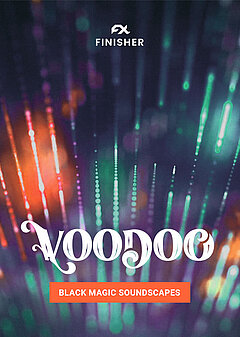Shaping the Sound of Your Guitar
How to radically transform your signal through an effect chain that captures the sound already in your head. Enter Finisher VOODOO.
MAY 30TH, 2020
You have a clean guitar and want to morph it into something wild; or maybe you know the exact sound you want to create, but don’t know what tools you need to get the job done. Even if you’re just looking for how to improve guitar sounds, you’ll find plenty of immediately actionable info here:
- What Affects the Sound of Your Guitar
- Different Types of Audio Effects
- How to Use Audio Effects
- Shaping Your Sound With Finisher VOODOO
For the purposes of this article, we’ll focus on the electric guitar for its flexibility and willingness to be bent to extremes mere mortals can barely comprehend.
If you still feel like you’re in the dark about exactly where to begin crafting the perfect sound for your guitar, we’re going to focus on foundational principles that will make the whole process much easier.
What Affects the Sound of Your Guitar
Regardless of how long you’ve been playing, you’re probably intimately familiar with how the body, strings, and pickup of an electric guitar color its tone; we’re going to focus on taking that original sound and bending, mangling, and punishing the tone to your heart’s content (or you could add effects sparingly and preserve the gorgeous sound you bought it for...but where’s the fun in that?).
The way you shape your guitar sound will of course vary greatly depending on what genre you’re playing in, how many other instrument tracks are competing for the listener’s attention, and how soft or hard you’re willing to go.
In a very broad sense, we’re talking about audio effects, which is to say anything that comes after the guitar signal coming into your DAW. With hundreds of plugin manufacturers and thousands of effect options, it’s challenging to decide exactly where to begin; fortunately, the vast majority of audio effects fall into a select few categories. Once you have a handle on them, it’s much easier to narrow your choice down to the ones that will get you closer to the perfect guitar tone for your needs.
Different Types of Audio Effects
Commonly used electric guitar effects typically fall into one of the following categories: delay, reverb, compression, filtering, flanging/phasing/chorusing and distortion. All are uniquely suited to a different purpose, but here’s a quick hit list to familiarize you with each:
- Delays generate note repetitions that gradually fade into the background. They’re often synced to the tempo of the song, and help thicken up the sound of your guitar and make it take up more space in the mix without layering additional instruments. A classic example is SoundToys’ EchoBoy.
- Reverb (or ambience) re-creates the sound of a physical space. This can be anything from a small studio to a concert hall, even from a cave to an “infinite” reverb for an extra spacey quality. For a few excellent reverb examples, check out Valhalla.
- Compression requires a lot of practice to get right and might be the most difficult effect to explain well; in essence, it makes the overall volume of the guitar track more consistent, and you can use it creatively to emphasize each transient (note attack) and bring up the level of the release. When you need your guitar to sound “big,” compression will likely be your go-to effect.
- Filtering involves playing with frequency balance (high vs. low); the most common application of this is the wah pedal, which achieves a vocal-like effect and is one of the most dramatic ways to shape the sound of a guitar.
- Flanging, phasing and chorusing are all similar effects with subtle differences, achieved by repeating the guitar signal at a very short delay (a few milliseconds). Instead of a second note, you hear a futuristic, watery pulse that fakes the sound of multiple guitars playing the exact same music but slightly detuned.
- Distortion is the premiere weapon of choice for many guitarists. There are many different distortion models, and most of them involve a crunchy, hot, grungy, or vintage sound that radically changes the timbre of your guitar signal. This is where you’ll make the most drastic changes to your sound. If you want to see just how deep this rabbit hole goes, try out Ohm Force’s Ohmicide.
How to Use Audio Effects
Once you route your guitar signal into an audio track, it’s time to tack on some of these and enhance guitar tracks with effects! While certainly not mandatory, it’s a good idea to set up an effect chain that at least resembles the final sound you’re going for.
Why?
Because the right effect chain can be a fantastic source of inspiration. Also, radically changing your effect chain after the fact can leave your guitar audio feeling weak, bloated, or at worst extremely messy. Distortion is especially critical to get right in the early phases of production, because you’ll naturally adjust your performance style based on the type and intensity of the distortion profile you choose.
If audio effect plugins are still quite new to you (or you’re simply one of those musicians who loves a renegade multi-effect plugin), read on!
Shaping Your Sound With Finisher VOODOO
If you want to hear just how far you can push the sound of a guitar into an entirely new sonic realm, try out the guitar effects software Finisher VOODOO. Load up the Pinball Machine preset and you’ll instantly transform even the cleanest guitar signal into a muted, plucked synth patch; or Cosmic Butterflys, which will instantly turn your signal into an open, atmospheric pad. Playing with Voodoo is especially fun when you’re riffing on a single idea and want to see how far you can push it by tagging on various effects all at once.
VOODOO is especially powerful if you’re ready to dive into the wealth of options afforded to you by audio effects but aren’t yet sure where to start. Try running a clean guitar signal (either from an instrument or one of our Virtual Guitarists) through it so you can see exactly what it’s capable of.
When you see settings like “Evil” and “Black Hole,” don’t be concerned–these aren’t new effect types we failed to mention earlier! Nearly every custom-named setting fits into one of the types stated above (for example, “Amp Heat” is distortion, and “Comb Sens” is phasing). The names change slightly so you can get a feel for the way each effect type will impact your sound. We strongly recommend it for aspiring guitarists and producers because it allows you to try out a broad range of effects from gritty to completely liquified, without having to perfect your digital signal processing (DSP) knowledge first. Seasoned performers will appreciate the wealth of opportunities to drop a complex effect chain on a track, especially when all you need is a quick enhancer or a specialized sound that’s already prepared for you.
Keep in mind that it’s not only your effect chain that determines your final sound; the notes you choose (to say nothing of style!) and the rhythm you impart will always be the most important piece. The real benefit of using effects is fully realizing the sound you want to create through your chords, melodies and riffs.
Have you already seen our quick-start guide to writing your own original guitar riffs? If you follow along, you’ll be well-poised to dive into designing the most unique and exciting effect chains for your own tracks. As a guitarist, there’s almost nothing more satisfying than getting your “sound” just right–and what better way than to blend the right riffs with a bold guitar effects VST across your signal chain?
Have fun playing with your own audio effects, and remember to look to VOODOO when you’re starving for inspiration!
Stay up to date
Sign up and we’ll send you an e-mail with product news and helpful stuff every now and then. You may unsubscribe at any time.
Defy Limits
We develop software solutions that enable people to create, consume and interact with music.




